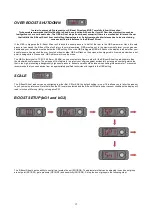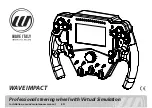
4
-
Check the signal from the negative terminal is a square wave that is switching between switching between 0V and 3.5-12 volts with
an appropriate meter. If the voltage is below 3.5V (coil trigger signals tend to have a very low voltage) the e-Boost will not read a
signal. In this case, a signal amplifier (also known as a tach adapter) must be used to boost the signal.
-
Connect the RPM signal wire from the E-Boost Street to the negative terminal of an ignition coil or tach adapter (which ever
method is used).
-
Turn on the E-Boost Street and configure your signal to the number of cylinders or rotors your engine has using the CYL (cylinder)
parameter located in the setup menu
-
In live mode with your engine running press mode once to show live RPM. The display should be reading RPMx100 e.g. 015 on
the display indicates 1500 RPM. If the display is not reading correctly re-check the cylinder configuration in the setup menu.
Vacuum/pressure signal
The E-Boost Street requires a vacuum/pressure signal from the intake manifold to function. A combination of poly tube and silicone
hose is used to connect the E-boost Street to a adequate vacuum/pressure signal. Route the poly tube from the E-boost Street
head unit through the fire wall approximately 100mm (4”) only as the poly tube is not rated to the high temperatures of the engine
bay.
Use the connecting barb to join the poly tube to the 3mm ID silicon hose at the firewall/bulkhead. Ensure the poly tube is pressed
all the way onto the connecting barb
Route the silicon hose through the engine bay and connect it to a pressure/vacuum signal from the inlet manifold. Use the supplied
tee piece if necessary.
Secure all connections with the supplied hose clamps
Installing the E-Boost Street Solenoid
-
The E-Boost Street solenoid is rated to a maximum temperature of 100
degrees Celsius (212 degrees Fahrenheit), ensure that it is mounted a
minimum of 250mm (10 Inches) away from the heat of the turbo or
exhaust manifold, otherwise heat shielding maybe required.
-
Mount the E-Boost Street solenoid in an appropriate position in the
engine bay with the mounting kit supplied.
-
Fit the rubber grommet inside the mounting plate. Slide the sleeve
inside the grommet. Use the M3 screws to bolt the solenoid to the
mounting bracket
– Note use loctite on the threads to secure. Use the
M6 screw, washer and Nyloc nut to mount in a suitable location in the
engine bay.
-
The E-Boost Street head unit is capable of controlling two solenoids. The use of twin solenoids is not necessary but is
recommended in twin turbo setups on V configuration engines as this reduces the length of hose required for plumbing which aids
in response and control of the wastegates.
-
The solenoid must be connected to a pressure only source which must be located before the intercooler, ideally off the compressor
cover of the turbocharger. The air temperature before the intercooler is less affected by ambient conditions which will give you
more consistent boost control.
SOLENOID HOOK UP METHODS
WARNING!
Changing to different connection method can cause a higher than expected increase in boost pressure. Turbosmart
recommends adjusting your boost controller back to its minimum setting and measuring the new minimum boost pressure achieved by
the new setup before increasing your boost again.





































